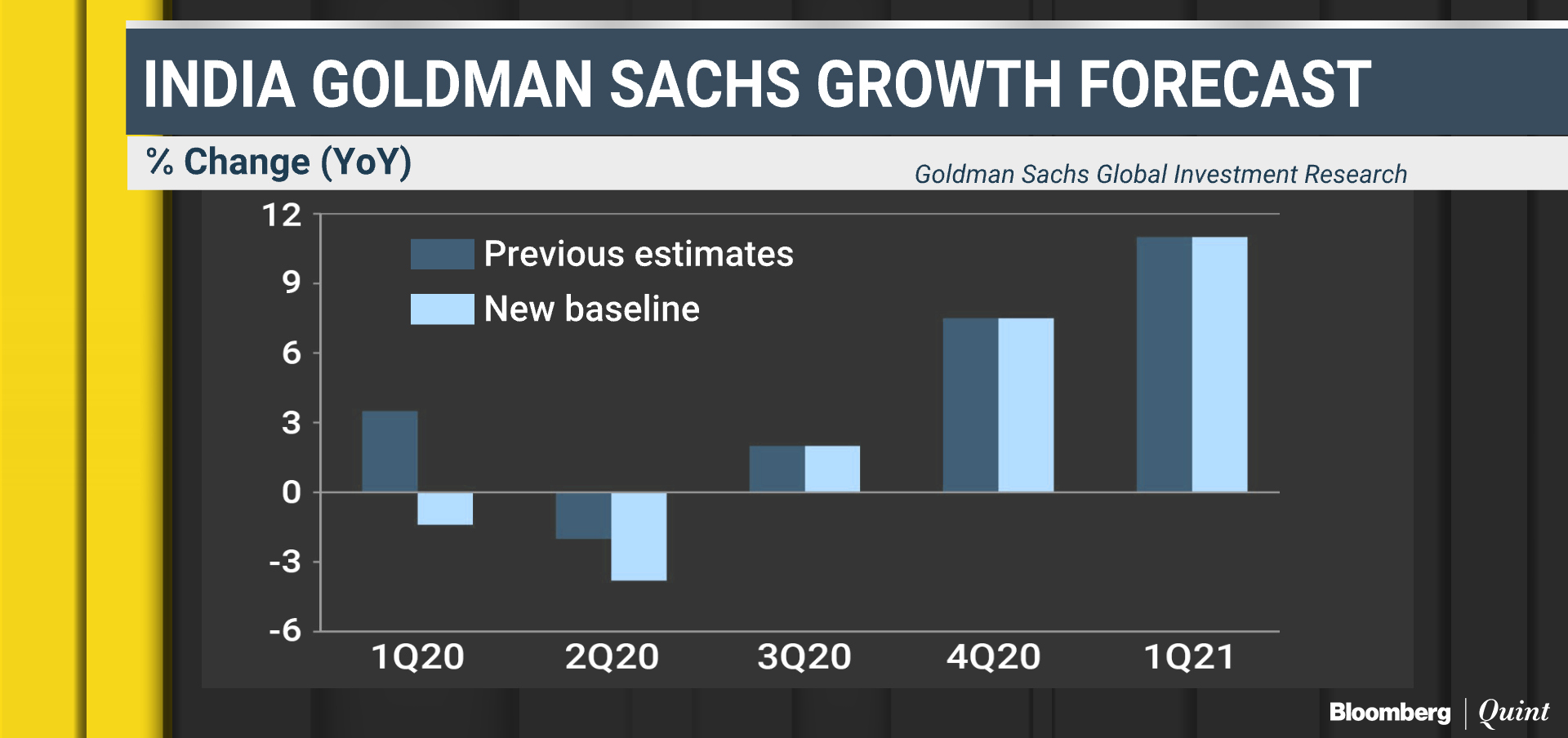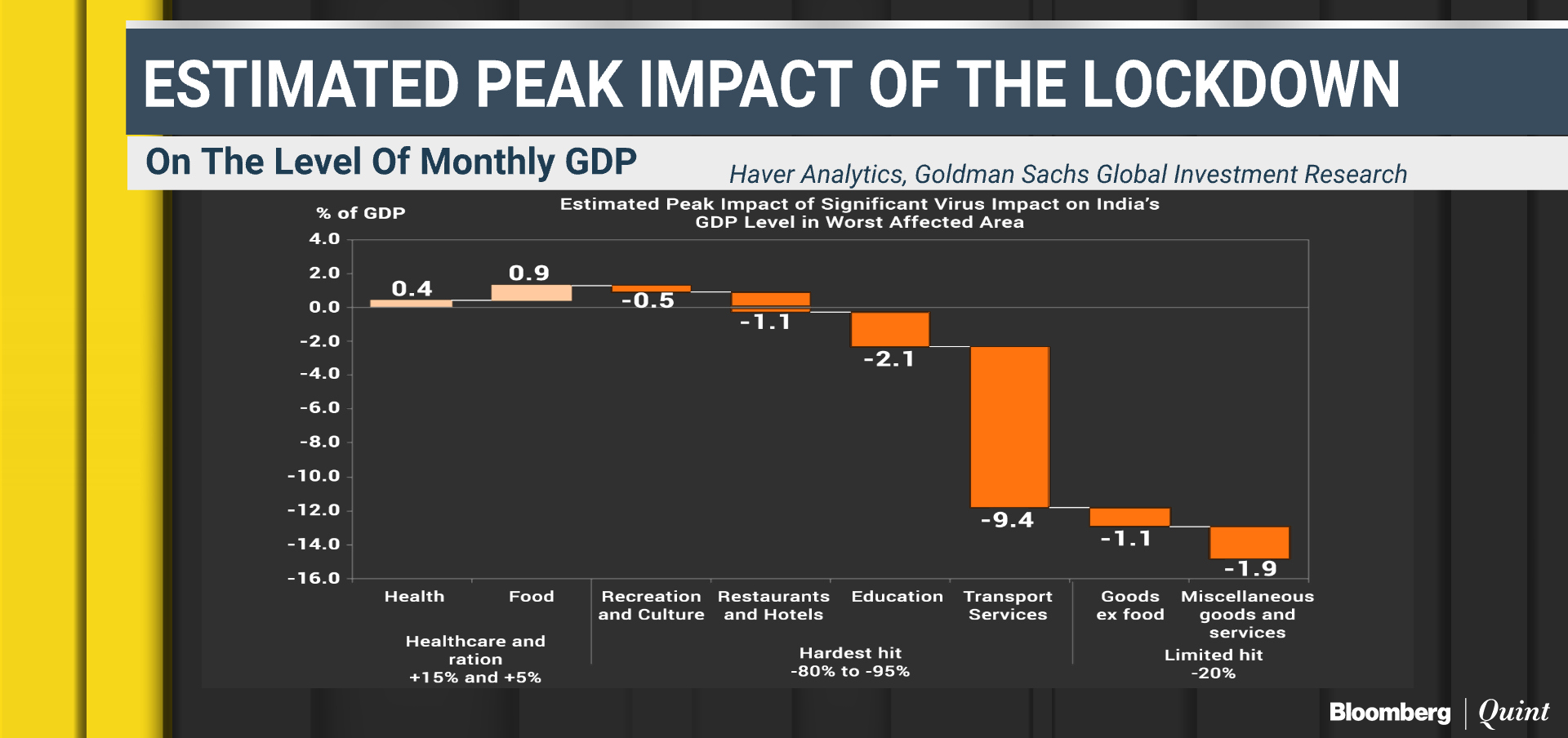 09-04-2020
09-04-2020
Coronavirus Impact: Goldman Sachs Sees India GDP Growth Plunge To 1.6% In FY21

 Insurance Alertss
Insurance AlertssCoronavirus Impact: Goldman Sachs Sees India GDP Growth Plunge To 1.6% In FY21
Growth in the Indian economy could fall to levels not seen for decades as key sectors see a sharp decline in business during the 21-day coronavirus lockdown and a likely staggered exit from those restrictions.
Goldman Sachs now forecasts that India’s real GDP growth could fall to 1.6 percent in FY21 compared to its earlier projection of 3.3 percent, it said in a report titled An Unprecedented Sudden Stop for India. The research house has pared its growth forecast for the second time now. Before the local spread of Covid-19 accelerated, Goldman Sachs had pegged growth at 5.8 percent in FY21.
“This is a gigantic 420-basis-point downgrade,” Prachi Mishra, chief India economist at Goldman Sachs, told BloombergQuint in an interview.
To be sure, India’s lowered GDP growth forecast comes amid steep downgrades for global growth as well. Goldman’s forecasts suggest:
- Global GDP will contract by 2 percent
- United States GDP will contract by 6.2 percent
- Eurozone GDP will contract by 9 percent
Explaining the contributors to the lowered growth forecast for India, Mishra said decline in global growth and the elasticity of India to this global slowdown would shave off 150 basis points from India’s real GDP growth. The local lockdown and a scenario in which there is a staggered exit would shave off 220 basis points from growth. The remaining contribution would come from investment spillover from the global and local disruption, Mishra said.
In total, we get a 420-basis-point downgrade to India growth estimates, clearly a giant downward revision in India growth outlook. In level terms, this downgrade assumes a 4 percent contraction in the level of real output in 2020-21 relative to a no-virus counterfactual.

Goldman’s sectoral analysis shows that the steepest hit will come from the transportation, education, restaurants and recreation sectors. This has been calculated using the level of activity in these sectors and their contribution to GDP.
“We now assume a larger hit up to 95 percent on recreation and culture, and restaurant and hotels sectors (vs. 70-80 percent previously) and increased the hit to education services up to 80 percent (vs 60 percent earlier),” Mishra wrote in her report. “In total, our assumptions about consumption cutbacks in these categories imply a monthly hit to the level of annual GDP of around 1.2 percent, for each month the lockdown is in place,” the report said.
The shock is intrinsically different this time. The one key difference between the global financial crisis and this time is that the fear and scare factor was not prevalent during previous period of stress.... Covid-19 represents a unique physical constraint on physical activity. And when the constraints are physical, the quarterly contractions in economic activity can be very steep.

Mishra is anticipating more fiscal support for the economy. So far, the government has announced a package of Rs 1.7 lakh crore or roughly 0.8 percent of GDP. She also assumes another 50 basis points in interest rate cuts from the Monetary Policy Committee and liquidity support from the RBI.
This increased support will be critical to reaching even a 1.6 percent GDP growth in FY21, Mishra said. The risks to this forecast are to the downside, particularly if adequate support is not forthcoming. “The 1.6 percent growth projection assumes a strong sequential recovery. That expectation is based on three assumptions—a staggered exit from lockdowns, further stimulus from the central and state governments and continued easing from the RBI,” Mishra said.
While fiscal support may be necessary, funding this additional spending in India is not easy due to already existing high public sector borrowings. “However, what is important to note at this juncture is that these are more medium- to long-term arguments. Right now the global and domestic economy is facing an unprecedented shock and that requires an unprecedented response.”
Mishra said that, in India’s case, fiscal support will have to be targeted and temporary. Additional spending, according to her, needs to be channeled towards the healthcare sector, given that existing spending on public health is less than 1 percent of GDP. “This is already happening but needs to happen more.” Second priority for government support needs to be households and small businesses, Mishra said.
Should the RBI step in to support the increased funding needs for the government and consider extraordinary measures? Mishra thinks they may have to.
“This is an unprecendented shock and extra-ordinary responses will have to be thought through and we will see more of that going forward.”
Source: Bloomberg quint
